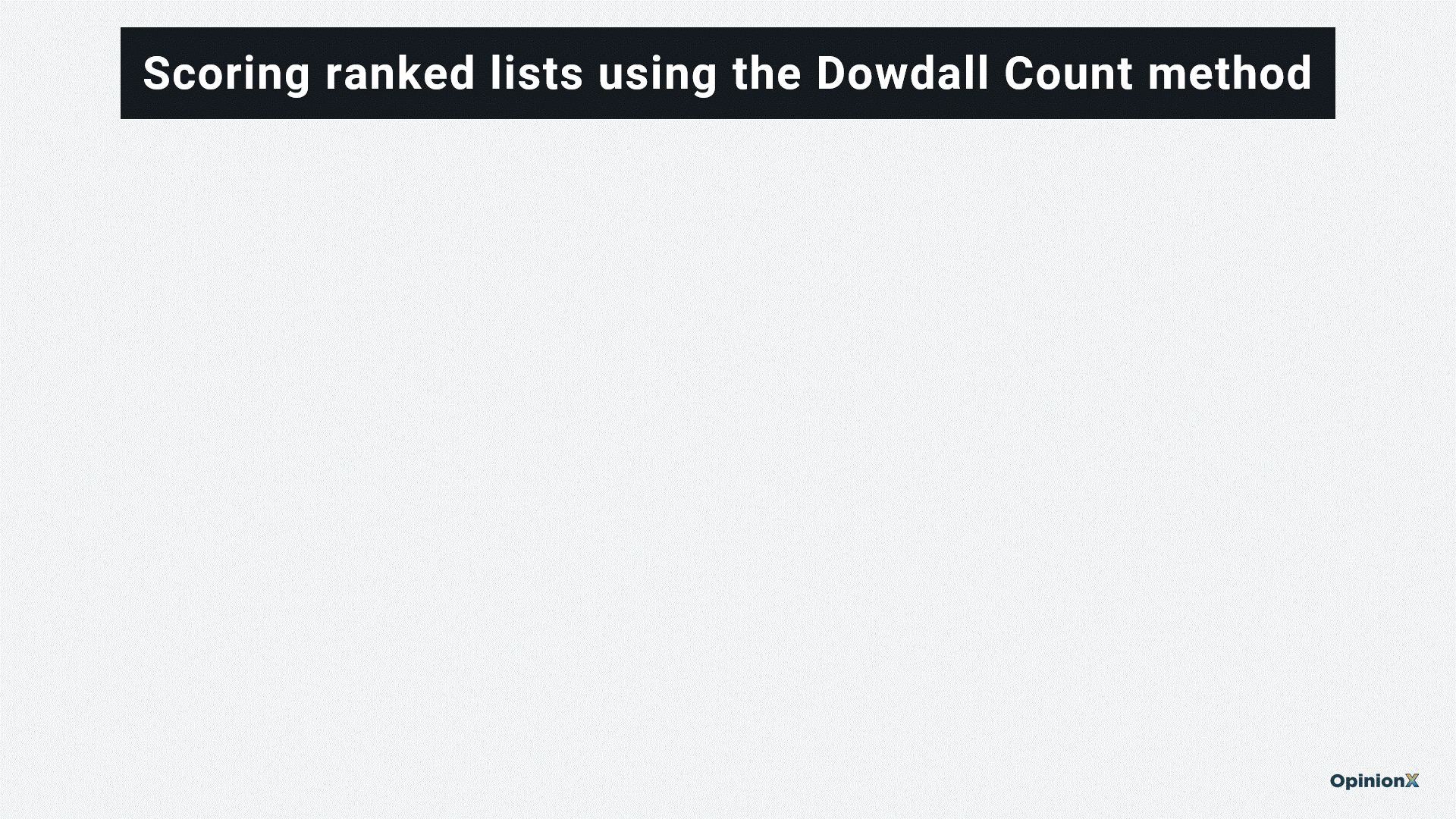How To Rank Any List of Names (Methods, Examples, Tools)
Whether you’re launching a new podcast, creating a new brand, or just trying to bring a team of people together, picking a name that everyone is willing to get behind is a tough task. Names are subjective and people associate different feelings and connotations with each option you present.
There are many voting methods that are ideally suited to ranking a subjective list of options like potential names while giving everyone a fair say in the final decision — this blog post explains each one and includes interactive examples to help you figure out which voting method you like best.
7 Voting Methods for Ranking Any List of Names
All six of these ranking methods are available for free on OpinionX, where you can create surveys with unlimited ranking options and engage unlimited participants, all without paying even $1. In each example below, you can see the real results of the embedded voting poll once you’ve finished voting.
1. Pairwise Comparison
Pairwise Comparison breaks your list of names down into a series of head-to-head pair votes to measure which one is the most preferred overall. It’s the most ideal method for ranking subjective things like a set of potential names which can be very difficult to rank in one simple list.
A pairwise comparison survey turns your list of names into a series of head-to-head votes and automatically calculates the results using a formula called win-rate analysis, which counts the percentage of pair votes that a name “won”. This simple formula makes your results very easy to understand — every name is given a score from 0-100 that represents how often it was picked as the more preferred option (ie. a score of 80 means that it was picked as the better name in 80% of head-to-head pairs it appeared in).
— — —
2. Points Allocation
Points Allocation gives each participant a set of credits that they can distribute amongst a set of options according to their personal preferences. Unlike Pairwise Comparison, which measures people’s subconscious preferences, Points Allocation is a fun and engaging way to elicit people’s considered preferences.
Also known as “Constant Sum” surveys, this method allows voters to show how much they like certain options by allocating many of their limited points to a single option. For example, we don’t just learn that Simon prefers apples to bananas, we see that he would give 9 of his 10 points to apples (Simon really likes apples…).
— — —
3. Ranked Choice Voting
The best-known of the ranking methods in this list is Ranked Choice Voting, which shows participants the full list of options and asks them to place them in order of their personal preferences. It is also commonly known as Rank Ordering or Drag-and-Drop Ranking.
There are many different ways that Ranked Choice Voting results can be calculated. OpinionX uses a format called the Dowdall Method, which assigns each ranked option a score of 100/rank (eg. your 4th favorite option would get 100/4 = 25 points).
I’m a big fan of the Dowdall Method for its flexibility — it lets respondents only rank what is relevant to them while excluding options they don’t care about or find irrelevant. It also puts more emphasis on your favorite options when turning ranked lists into scores, which is great for participants trying to represent their strong opinions. “Borda Count” methods are used by almost all other survey tools but they only work when every respondent ranks the same number of options, which is an unnecessary limitation compared to the Dowdall Method.
— — —
4. Consensus Poll
Consensus Polls show participants each option and ask them to agree or disagree with a stated premise, such as whether the option shown would be a suitable name. Each name gets shown one at a time in this quick agree/disagree poll.
These agreement ranking questions are non-comparative, which is an important thing to consider before picking this method. Participants are not forced to compare options against each other, instead you are just seeing which one is liked by the highest percentage of people (ie. got the largest share of “agree” votes) — a result that is very different to measuring which names are most strongly preferred.
— — —
5. First Past The Post
The most basic of ranking methods is a simple one-vote poll, where you show the list of options and ask respondents to only pick their favorite. This single-choice poll will show which option has the highest initial preference rate amongst respondents. I would only recommend using this if you have a very short list of options, like 2-5 at most, otherwise your results are unlikely to represent people’s more complex preferences that this would fail to capture.
— — —
6. Image Ranking
Images can help people to better contextualize the names they are voting on. You can add images to any of the ranking methods from this blog post — for example, check out the image ranking survey below that uses the Pairwise Comparison voting format:
— — —
7. MaxDiff Analysis
MaxDiff Analysis ranks people’s preferences by asking them to choose the best and worst option from a group of 3-6 statements. Each time the respondent votes, a new set of statements from the overall list of ranking options is shown. The “best” and “worst” labels in a MaxDiff survey can be changed to suit your research occasion, such as Favorite / Least Favorite, Top / Bottom, or Most Preferred / Least Preferred.
— — —
Create Your Name Ranking Survey
OpinionX is a free tool for creating ranking surveys. You can create unlimited surveys with any of the ranking methods from this post and invite unlimited participants to complete your survey, all completely for free (no time limit or credit card required). Figure out which name from your list is best by creating a free ranking survey on OpinionX.
— — —

